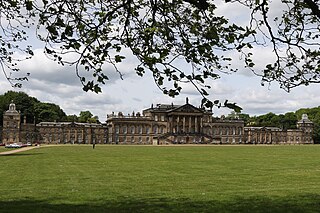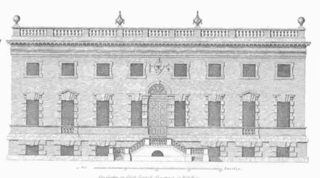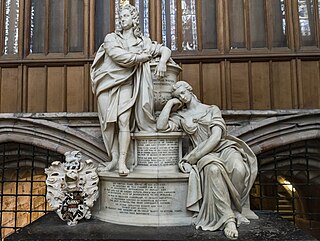
Blenheim Palace is a country house in Woodstock, Oxfordshire, England. It is the seat of the Dukes of Marlborough. Originally called Blenheim Castle, it has been known as Blenheim Palace since the 19th century. One of England's largest houses, it was built between 1705 and 1722, and designated a UNESCO World Heritage Site in 1987.

Wentworth Woodhouse is a Grade I listed country house in the village of Wentworth, in the Metropolitan Borough of Rotherham in South Yorkshire, England. It is currently owned by the Wentworth Woodhouse Preservation Trust. The building has more than 300 rooms, with 250,000 square feet (23,000 m2) of floorspace, including 124,600 square feet (11,580 m2) of living area, and was – until it ceased to be privately owned – often listed as the largest private residence in the United Kingdom. It covers an area of more than 2.5 acres (1.0 ha), and is surrounded by a 180-acre (73 ha) park, and an estate of 15,000 acres (6,100 ha).

Thomas Wentworth, 1st Earl of Strafford,, was an English statesman and a major figure in the period leading up to the English Civil War. He served in Parliament and was a supporter of King Charles I. From 1632 to 1640 he was Lord Deputy of Ireland, where he established a strong authoritarian rule. Recalled to England, he became a leading advisor to the King, attempting to strengthen the royal position against Parliament. When Parliament condemned Lord Strafford to death, Charles reluctantly signed the death warrant and Strafford was executed. He had been advanced several times in the Peerage of England during his career, being created 1st Baron Wentworth in 1628, 1st Viscount Wentworth in late 1628 or early 1629, and, finally, 1st Earl of Strafford in January 1640. He was known as Sir Thomas Wentworth, 2nd Baronet, between 1614 and 1628.

Earl of Strafford is a title that has been created three times in English and British history.
Captain William Winde (c.1645–1722) was an English gentleman architect, whose military career under Charles II, resulting in fortifications and topographical surveys but lack of preferment, and his later career, following the Glorious Revolution, as designer or simply "conductor" of the works of country houses, has been epitomised by Howard Colvin, who said that "Winde ranks with Hooke, May, Pratt and Talman as one of the principal English country house architects of the late seventeenth century".

Colen Campbell was a pioneering Scottish architect and architectural writer who played an important part in the development of the Georgian style. For most of his career, he resided in Italy and England. As well as his architectural designs, he is known for Vitruvius Britannicus, three volumes of high-quality engravings showing the great houses of the time.
The year 1705 in architecture involved some significant events.

Lieutenant-General Thomas Wentworth, 1st Earl of Strafford, KG, also known as in Jacobite Peerage as the 1st Duke of Strafford and 3rd Baron Raby from 1695 to 1711, was an English peer, diplomat and statesman who served as First Lord of the Admiralty.

Robert Smith was a Scottish-born American architect who was based in Philadelphia and was the architect for some of the city's most prominent early building structures, including Carpenters' Hall, St. Peter's Episcopal Church, and the steeple on Christ Church. These structures constituted the greater part of Philadelphia's early skyline.

Wanstead House was a mansion built to replace the earlier Wanstead Hall. It was commissioned in 1715, completed in 1722 and demolished in 1825. Its gardens now form the municipal Wanstead Park in the London Borough of Redbridge.

Johann Dientzenhofer was a builder and architect during the Baroque period in Germany.
Wentworth Castle is a grade-I listed country house, the former seat of the Earls of Strafford, at Stainborough, near Barnsley in South Yorkshire, England. It is now home to the Northern College for Residential and Community Education.

William Wentworth, 2nd Earl of Strafford, styled Viscount Wentworth until 1739 was a British peer and member of the House of Lords of Great Britain.
There have been five baronetcies created for persons with the surname Wentworth, four in the Baronetage of England and one in the Baronetage of Great Britain. All creations are extinct.

Richard Child, 1st Earl Tylney, was an English politician who sat in the House of Commons between 1708 and 1734. Initially a Tory, he switched to supporting the Whigs after 1715. He held no Office of State, nor any commercial directorship of significance, but is remembered chiefly as the builder of the now long-demolished Palladian "princely mansion" Wanstead House, one of the first in the style constructed in Britain. In the furnishing of his mansion Child became the main patron of the Flemish painter Old Nollekens. He died in March 1750 aged 70 at Aix-en-Provence, France, and was buried on 29 May 1750 at Wanstead.

George Byng of Wrotham Park in Middlesex, was a British politician who sat in the House of Commons from 1768 to 1784.
James Essex (1722–1784) was an English builder and architect who mostly worked in Cambridge, where he was born. He designed portions of many colleges of the University of Cambridge, and carried out major restorations of the cathedrals at Ely and Lincoln. He was an admirer of Gothic architecture, and assembled materials for a history of the style, though the book remained unpublished.

Hon. Thomas Watson, later known as Thomas Watson-Wentworth, of Wentworth Woodhouse in Yorkshire, was an English landowner and politician who sat in the House of Commons between 1701 and 1723.

5, St James's Square is a Grade II* listed historic townhouse in London, England, built 1748–51 by William Wentworth, 2nd Earl of Strafford (1722–1791) to the design of Matthew Brettingham the Elder. It remained the London residence of the descendants of his sister until after 1968, and in 1984 was the site of the "Libyan Peoples' Bureau" from which shots were fired which caused the murder of Yvonne Fletcher.














